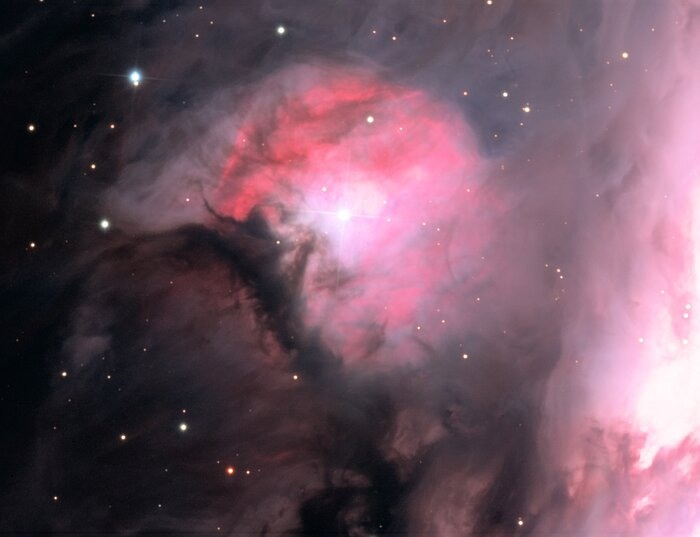Messier 43, also known as De Mairan’s Nebula, is a fascinating astronomical object located in the constellation of Orion, and situated within the larger Orion Molecular Cloud Complex. It is just to the north of the famous Orion Nebula (M42) and forms a part of the Orion Nebula’s extended structure. Here’s an overview of this celestial object:
Appearance
M43 spans approximately 20 arcminutes in diameter, which is equivalent to about two-thirds of the apparent size of the full moon. It is relatively smaller in size compared to the adjacent Orion Nebula (M42) but is still easily visible with telescopes and even binoculars under dark skies.
The nebula appears as a distinct patch of nebulosity adjacent to the brighter regions of the Orion Nebula. It is illuminated by the light of nearby stars and exhibits a bluish hue similar to the Orion Nebula. M43 is sometimes referred to as a “miniature” or “secondary” nebula compared to the latter, but it still possesses its own unique characteristics and features.
Composition
Like the Orion Nebula, M43 primarily consists of interstellar gas and dust, primarily hydrogen gas, which is ionized by the intense ultraviolet radiation emitted by nearby hot stars. The radiation excites the hydrogen atoms, causing them to emit light as they recombine with electrons. The nebula also contains other elements such as helium, oxygen, and nitrogen, along with dust grains composed of silicates and other compounds.
The ionization of these elements further enhances the nebula’s luminosity and contributes to the complex interplay of colors seen in images. This environment not only highlights active star formation but also plays a crucial role in the chemical enrichment of the surrounding interstellar medium as these elements are released during stellar processes
Discovery
The nebula was first observed by the French astronomer Jean-Jacques Dortous de Mairan in the early 18th century. De Mairan’s observations of this nebula contributed to our understanding of nebulae as extended objects in space rather than mere unresolved stars.
Observation
M43 is best observed using telescopes equipped with low to moderate magnification under dark sky conditions. It can be easily found by locating the bright star cluster known as the Trapezium within the Orion Nebula (M42) and then shifting slightly northward to find M43. Observers can also use star charts or astronomy apps to pinpoint its location.
M43 is best observed during the winter months in the Northern Hemisphere (from November to March) and the summer months in the Southern Hemisphere (from October to February), with peak visibility in December and January for Northern observers and in December for Southern observers when Orion is at its highest point in the sky.

Photography
Photographing M43 requires long-exposure astrophotography techniques to capture its faint nebulosity and intricate details. DSLR cameras or dedicated astrophotography cameras mounted on telescopes can capture stunning images of this nebula and its surrounding star-forming region.
Overall, M43, or De Mairan’s Nebula, is a captivating object in the night sky, offering astronomers and observers a glimpse into the ongoing process of star formation within the Orion Molecular Cloud Complex.



